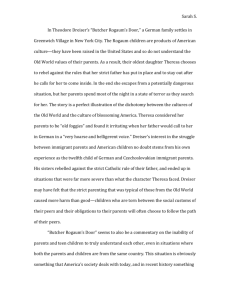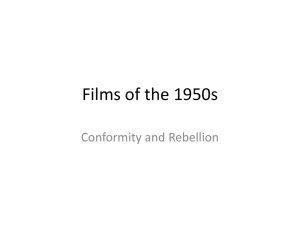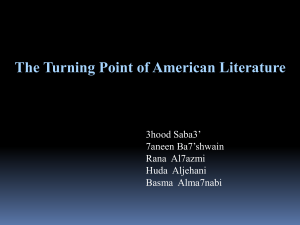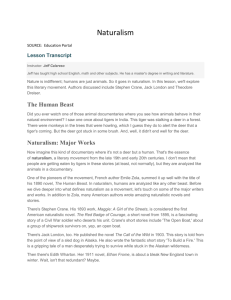The Plays of Theodore Dreiser
advertisement
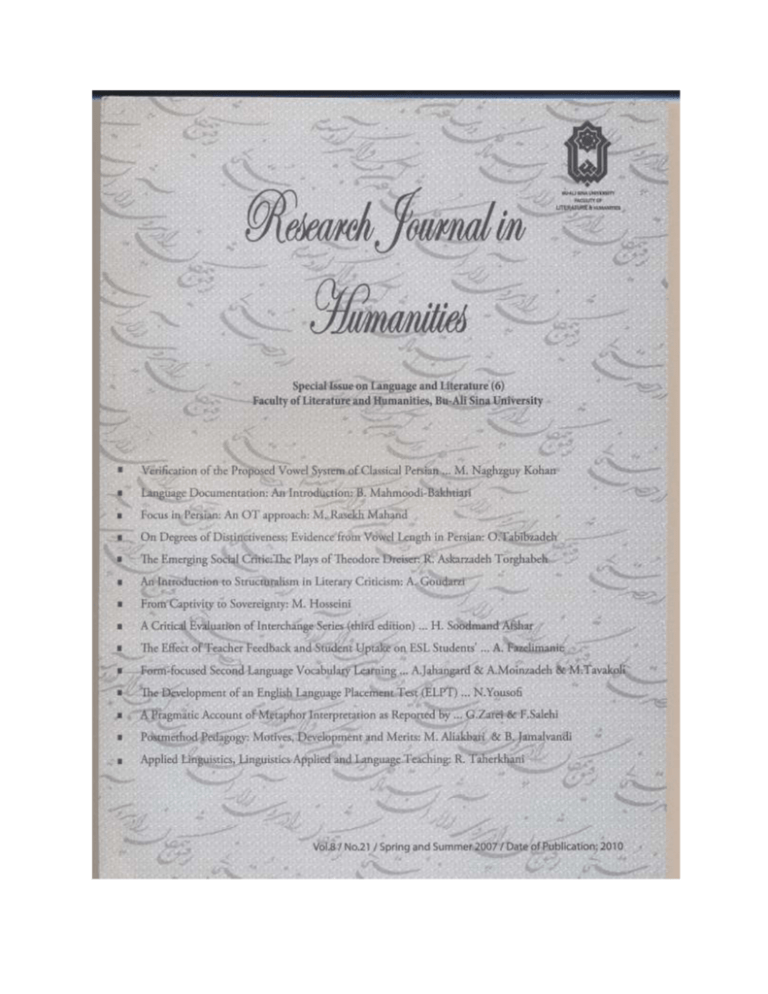
The Emerging Social Critic: The Plays of Theodore Dreiser Dr. Rajabali Askarzadeh Torghabeh1, Assistant Professor, Department of English, Ferdowsi University of Mashhad. Abstract Theodore Dreiser is one of those great American novelists and playwrights who appeared in the world of drama in the first decades of the Twentieth century. His ideas on life, death and society are unique; and the way he treats poor and the abnormal, all provide very valuable insight into the works of such a great novelist and playwright. Dreiser’s drama is a very special one that criticizes the society and its laws for ignoring and not considering its own people. In his plays, Dreiser clearly shows how society is unjust, and how people are condemned and sacrificed in such a society. Keywords: American dramatic literature, social criticism, Theodore Dreiser. The Emerging Social Critic: The Plays of Theodore Dreiser Introduction Modern American drama as a serious form of art is the product of twentieth century. American dramatists have been concerned with interpreting reality both freshly and imaginatively in terms of story, dialogue and character. They have had something topical to say comparable to what has been expressed in other literary forms. American dramatists of the twentieth century have been more realistic than their predecessors, not merely in actual observation and report but in psychology and motivation. A new conception of the importance of drama and a desire for self-expression and the expression of reality, led to the establishment of amateur groups interested in acting, direction, design, the organization of audience, financing, and building of theatres. This development of dramatic taste reflected a gradual aesthetic, social and economic change. In the first decade of the century, Chicago was a leader in this transition, with its Donald Robertson Players, Hull House Players, New Theatre, and the Drama League. In the first decade of the Twentieth century knowledge of European productions by the Moscow Art Theatre, and by Max Reinhardt, and of the scene designs of Adolph Appia and Gordon Craig began to affect such American artistes as: Robert Edmond Jones, Sam Hume, Norman Bel Geddes and Lee Simon Son. Partly under their influence, partly stimulated by an extended literary appreciation, partly by a new artistic awakening and enthusiasm, and partly because it was fun, various new production groups were formed (Bigsby, 1985). Of these perhaps the most important for the American dramatists were the Provincetown Players and the Washington Square Players. Provincetown Players were a group of young intellectual Bohemians, producing first at Provincetown and then in Greenwich Village. They worked for an institution called “The Little Theater Movement” that came into being in 1915. The Provincetown Players, for all their amateurism were interested in providing a break to the American writers who wished to test the potential of the stage, and who were thereby instrumental in causing the explosion of the experimental theatre. This group produced works by Elmer Rice, Sidney Howard, S.N. Behrman, Eugene O’Neill, Maxwell Anderson as well as the plays of Theodore Dreiser. Theodore Herman Albert Dreiser was born in 1871. He was a novelist, playwright and also a journalist. His first novel entitled Sister Carrie appeared in 1900. Dreiser's second novel, Jennie Gerhardt, was published in 1911. His first commercial success was An American Tragedy, which appeared in 1925. Free and Other Stories is Dreiser's first collection of short stories that was published in 1918. Since Dreiser is considered a successful novelist, it is generally not known that for a time Theodore Dreiser had thought of his talent as essentially dramatic. This playwright had written eight one-act plays, seven of which were published under the title, Plays of the Natural and the Supernatural (1916), and a full-length play in four acts entitled: The Hand of the Potter (1918), all during the period 1915 to 1918. As specimens of dramatic art, these attempts have not been regarded highly. But as expressions of Dreiser’s ideas on life, death, society and its treatment of the poor and the abnormal, they provide very valuable insight into the working of Dreiser’s mind. Of particular significance is the important perspective the plays offer on his social criticism at a time when he was being hailed as “the champion naturalist who believed only in the survival of the fittest” (Henderson, 1986:49) and showed no concern for the poor and the socially oppressed classes. His novel The Titan (1914) written about the same time as the plays, was taken as an expression of the ‘superman’ cult and Dreiser himself as its votary. It is rather unfortunate that an excessive concern with Dreiser’s naturalism has prevented a proper appreciation, or even an adequate examination, of his social and political writings and his role as a social critic. His first play, The Girl in the Coffin, written in 1913 is also Dreiser’s first creative work which was more or less wholly concerned with the theme of social strife. Thus, in a way, this play is a forerunner of the drama of social criticism in America in the thirties, when Elmer Rice, Maxwell Anderson, John Howard Lawson, Clofford Odets and others wrote their plays, and The Group Theater and the Theater Union emerged to “devote themselves primarily to plays of social criticism from the point of view of the left” (Krutch, 1939:247). Discussion An examination of the Dreiser corpus reveals that his involvement with social problems was not confined to his latter years alone; it is there in all his writings in varying degrees from his earliest journalistic attempt in the 1890’s to his fervent call for social harmony and co-operation a few months before his death2. As editor of Ev’ry Month from October 1895 to September 1897, Dreiser had a free hand for the first time and one of the first things he did was to introduce a column called ‘Reflections,’ which he contributed regularly. Through this column he expressed his ideas on a variety of subjects addressed directly to the readers. These ‘Reflections’ show that as early as 1895 he was writing of social corruption and the ways of eradicating them and establishing proper norms for public life and conduct. His crusade for social reform in the thirties and later, it would therefore seem, was “neither sudden nor inexplicable,” (Shank, 1982:56) as has been made out by almost every American critic. As one committed to faithfully portraying life, as he saw it in all its nakedness, Dreiser could not but be powerfully affected by the unrest prevailing in the working class during his formative years. By the time Dreiser entered life in the 1890’s, conditions in the United States had greatly changed. With the end of the era of free land, the opportunities for the less fortunate to escape from intolerable conditions became more limited. Class consciousness and the conflict between capital and labor were on the increase. A section of the capitalists believed in a “philosophy of grab in utter disregard of the principles of fairplay and the rights of other individuals” (Walzer, 1992:125). The plight of workers, in particular, was far from satisfactory and they had to fight for most of their rights and proper conditions of work. As Nevins and Commager (1956) write: The story of American labor is checked with strikes and violence. From the beginning, labor has had to fight for most of its gains: for the right to organize, to strike, to picket, for shorter hours and higher wages…in this prolonged and bitter warfare, labor has for the most - See Dreiser’s poem, ‘What to do,’ Free World, Vol: IX, March, 1945, p.10, and his article, ‘Interdependence,’ Free World, Vol: X, September, 1945, p.70. 2 part stood alone, while business has found powerful allies in public opinion, the police and the courts…from 1882 to 1905 there occurred no less than thirty-seven thousand strikes, some of them brief and local, and some of them prolonged and nationwide (281). Dreiser was deeply moved by the miserable conditions of the workers he saw. In fact “his sympathy was always with the underdog” (Kirkpatrik, 1988:99) and in his account of his tour of England in 1911, he had described it with great feeling the pathetic conditions of the laborers and the slum areas of Manchester where “the air was wet, smoky, gray…faces – pale, waxy, dull and inefficient” (Dreiser, 1913:177). Dreiser was, however, impressed by the work of the labor leaders and hoped “the conditions may not be so severe,” (Ibid, 178) and cherished “the idea of seeing the world growing better and more interesting for everybody” (Ibid, 179). One also recollects how in the face of severe and violent opposition, Dreiser fought for the striking coal miners of Harlan County, Kentucky, in the early thirties3. Dreiser’s choice of subject for his first one-act play is therefore quite understandable. Incidentally The Girl in the Coffin was also one of the first plays in American literature to deal with the labor-capital dispute and present the labor viewpoint, a theme very dear to Dreiser’s heart. The play with half a dozen characters, all mill workers and their wives, has hardly any action or conventional plot, but is “patterned after the drama of ideas” (Sangar, 2001:69). It is entirely concerned with the strike in the mill in a small town, and the refusal of William Magnet the foreman of the loom workers, to lead the strikes as he is stricken with grief on account of the death of his daughter, whose coffin lies on the stage in the background throughout. As McGrath exclaims: “My God, the fight’s only just begun! We gotta get’em all out and we gotta keep’em out 4 (Dreiser, 1916:34). Magnet, however, refuses to go and addresses the workers, and tells Ferguson, another strike leader: You can’t understand there’s some troubles comes first with a man. The whole world might be waiting for him to save it, but it’d have to wait. Nobody wouldn’t have any right to interfere. You don’t know - See Dreiser’s ‘Introduction’ in Harlan Miners Speak. New York: Vintage Books 1932. - Plays of the Natural and the Supernatural. New York: Vintage Books 1916. All subsequent references to this play in the text are to this edition. 3 4 what it is to a man, Ferguson, when somebody – when somebody – (45). And his voice breaks down. Ferguson, however, pleads with him and finally succeeds in persuading Magnet to subordinate his own personal grief to the larger interests of the workers. He tells Magnet that he too, is similarly afflicted with grief. Only at the very end of the play when Ferguson is left alone on the stage and is seen looking intently at the coffin, the fact is revealed, that he was the lover of the dead girl. This is perhaps “the only dramatic element in the play which otherwise turns out to be a dialogue between personal feelings and public duty” (Berkowits, 1992:66). Ferguson who turns out to be the most powerful character in the play seems to be Dreiser’s ideal of a selfless labor leader. He is the embodiment of devoted service for the exploited workers who suffer acute anguish at the misery of these people. Provoked by Magnet, he exclaims with sudden, passionate emphasis: …there’s one thing I don’t ever forget, Magnet – unhappiness is a lot easier to bear when you’ve got clothes to cover your back and food enough to hold your body and soul together. When I come to a town in the dead of winter and find twenty-five thousand people on the edge of freezing and starvation…it don’t seem to make very much difference to me whether I’m happy or not. As long as I can keep alive to fight for those poor devils, I’ll fight for’em…if there’s nobody else in this world I can count on, I know I can always count on myself…life can kill and bury my happiness, but it can’t kill and bury my courage (51-2). The play, however, is not so much concerned with individual characters as with the issues involved. Though the play, staged by Provincetown Players in New York, proved a failure, its theme and the question it raised were not lost on the people. Dreiser a quarter of a century later, in his letter to John Golden, claimed that he had tried to put “the whole question on a more realistic basis, which paints both sides gray” (1938). One can understand Dreiser’s reasons for saying so. As a play, this onesidedness was a flaw, as it took away the element of conflict, and John Golden, who wanted to produce the play, had rightly suggested a revision. But socialist producers and newspapers like the New York Call did not fail to notice the dramatist’s basis and applauded it as hard-hitting working class polemics, “a play in which the struggle of the people is told” (New York Call, Feb. 5. 1920). It may so be recalled that writing an article entitled “The Toil of the Laborer,” in the same paper the same year, he spoke feelingly of the plight of the workers: “of the meagerness of their wages,” (Ibid) and of his resolve never to “exact where I could not repay…not to be a tool in the hands of these [employers]…even though I could not relieve the situation of its pain” (Ibid). It is interesting to find a number of similarities between Dreiser’s play and John Galsworthy’s Strife, produced in England seven years earlier. Both plays deal with labor-capital dispute. In both of the plays, the chief character subordinates his personal feelings of grief and loss to the larger interests of the workers. In The Girl in the Coffin, Magnet’s daughter and Ferguson’s beloved is already dead when the play opens, and her coffin lying in the background is a grim reminder of the tragedy. In Strife, while leading the workers at a critical stage is told that his wife is dying. But while Galsworthy’s play is superior in technique and dramatic skill, and proved a great success on the stage, Dreiser’s play, as he himself used to say, was meant to be a ‘reading play.’ The Hand of the Potter (written in 1916, published in 1918), Dreiser’s other important and only full-length play, takes up the cause of those afflicted by abnormal sexuality, and tries to show the unjustness of society’s attitude toward such people. The treatment of themes challenging the conventional morality had become common in the thirties, and as Joseph Wood Krutch remarks, to these playwrights, “Freud was a prophet hardly less important than Marx” (Spiller, 1948:1239). But for a playwright like Dreiser to take up such a theme in 1916, especially when he was under constant censure for preaching immorality in his novel The Genius, was too bold a step. As a play, it is true that it hardly had any dramatic value. In a letter to Dreiser, Menkin’s advice to him was sound: “Put the Ms. Behind the clock, and thank me and God for saving you from a mess” (Dec. 20, 1916). But Menkin was apparently more concerned with the effect of the publication of such a play at a time when he was defending Dreiser against charges of immorality and obscenity. But to Dreiser his theme was as tragic as any other, and in his reply to Menkin, he retorted: I deny your ruling in connection with perversion and its place on the stage. Tragedy is tragedy, and I will go where I please for my subject…so long as I have adequate possession of my sense current convention will not dictate to me where I shall look for art (Dec. 21, 1916). The Hand of the Potter deals with the perverted sexual impulse of a young man, Isadore Berchansky, who is unable to control himself at the sight of any little girl. What in modern psychological terminology is known as ‘infanto-sexuality.’ He is first attracted by his sister, next his niece, and finally commits suicide after attacking and killing an eleven-year old daughter of his neighbor. Dreiser presents Isadore as a helpless “victim of natural impulses” (Worthen, 1992:125), who despite all his efforts, finds that he is unable to control himself. But is he, Dreiser seems to ask, to blame for his miserable state? As Isadore pathetically sobs: I know I’ll do sompin [sic] wrong pretty soon. I feel it. I can’t help it. I ought to kill myself [but even this would have been an offence in the eyes of society, the church and the law as well!] but I ain’t got the nerve. That’s what’s the matter…It ain’t my fault…I didn’t make myself, did I5? (1918: 45) The public reaction in 1918 to a play with such a theme can be easily imagined. One paper wrote: ‘Burn it…Turn Dreiser over to the psychiatric ward” (Chicago Tribune, n.d.). When Edward Smith directed and staged it at Provincetown Theater, it had a similar fate. The New York World found it “conspicuously offensive” (Swanberg, 1965:258), and the Herald called it a “repulsive play” (Ibid). In fairness to Dreiser, it must be borne in mind that he was not suggesting that such abnormal people be let loose and allowed to roam about unchecked in society. As Greenbaum, Isadore’s brother-in-law, suggests in the play itself “the best thing to do would be to put him in a home somewhere…where he would be looked after” (185). Dreiser was only pleading for a rational and liberal attitude towards these unfortunate people, whose only crime was that they were abnormal, and that was not their fault. Sex perverts, as Quinn, the newspaper reporter in the play tries to establish in the course of a long argument with his fellow reporter Leech, are no guiltier than any other person with a disease (193-200). 5 - The Hand of the Potter. New York: Basic Books, 1918. All subsequent references to this play in the text, are to this edition. Plays with supernatural elements, are also typical of Dreiser, and show his earnest and passionate quest for knowing the mystery of life and creation; and remind us of his proposed “Mechanism Called Man,” to which he devoted nearly three years later in life6. He attempted in these plays which seem to dramatize the eternal predicament of man yearning for an understanding of himself in a mysterious and often seemingly hostile universe. In his works, Dreiser’s use of the supernatural had been limited, but the plays mark a departure. In the novel he had attributed supernatural causes to events which seemed otherwise inexplicable, as telepathic communications between the lovers in Jennie Gerhardt. In his plays, he shows an interest in supernatural themes, which seem rather unusual for a realist. It appears that his inquisitive and credulous mind was attempting to explore the world of the unknown. He thought of his ventures into the realm of the supernatural as being an extension of his quest for the unknown, and not as any preoccupation with the occult7. In the Blue Sphere, Dreiser’s first play involving the supernatural, Eddie, a deformed child, is led to his death (he is crushed under the wheels of a passing train) by a beckoning lady called Shadow, a supernatural phantom. The child is thus a victim of an accident predestined by superhuman fate. The implication is that, there may exist some superhuman pattern of laws that govern our behavior over which human beings have little control. Of such plays, ‘Laughing Gas’, inspired by an experience Dreiser himself had, on taking nitrous oxide, is the most elaborate in expressing his reflections on life. Through the words of the physician, James Vatabeel, sleeping under anesthesia, and Alcephoran and Demyaphorn, two supernatural characters, Dreiser suggest the inscrutability of the universe. Vatabeel who is pondering over his inadequate knowledge of the vast mysteries of life, says: “the terror of the after life – Death? Annihilation? …The mystery of the blood, of articulated bones, of organized society. Poverty, waste, hunger, pain, wealth, sickness, health8 (99), then, told by Demyaphon: You puzzle over the phenomena of man. In a vain, cynical, ambitious way you dream. It will all be wiped out and forgotten. To - See Dreiser’s ‘Unclassified philosophical Notes’ 9Boxes-394-441), University of Pennsylvania. See also Neda M. Westlake, Theodore Dreiser’s Notes on Life, Library Chronicle, XX (Summer, 1964), 69-75. 7 - See Dreiser’s letter to Edward H. Smith, January 10, 1921. University of Pennsylvania. 8 - Plays of the Natural and the Supernatural. New York: Vintage Books, 1916. All subsequent references to this play in the text, are to this edition. 6 that which you seek there is no solution. A tool, a machine, you spin and spin on given course through new worlds and old. Vain, vain! For you there is no great end (100). On waking up, he is oppressed with a sense of futility and the meaninglessness of it all. In the Dark and Spring Recital, reinforce these implications. The latter contains one of Dreiser’s most explicit statements of the beauty, charm and the innate appeal of life for the human being, despite all its ultimate futility and frustration. Looking at the young pair of lovers, the third priest is reminded of the ancient Egyptians, the keenness of their thrill of existence, their greater reality, and all this “because of their faith in it” (172). At this, the Minister of St. Giles cries out: “I grieve for life, brother” (172). This utterance is significant indeed, for it conveys a dominant note in Dreiser’s thinking which runs like a plain song (despite his oft-repeated harangues at the cruelty and injustice of life) through all his writings – his zest and love for life and beauty. In his The Bulwark, which he completed shortly before his death, one recalls how Etta similarly exclaims: “I am crying for life” (Dreiser, 1948:337). No matter how tragic he found life, he retained an almost mystical faith in its beauty in all forms. It is this faith which sustained the artist in him (Callens, 1991). The same faith one finds in his Old Ragpicker. The Old Ragpicker is the very picture of misery, starving and homeless, but he finds life worth living as he can still “watch the water go by and the boats and the clouds” (Dreiser, 1948:216) 9. The play also draws pointed attention to the pitiable condition of poverty-stricken old men like the ragpicker and censures a society which allows such a state. As the old woman in the play remarks: “The ideal! Let him pick out of a garbage can at his age and in his condition. It’s a shame. That’s what it is” (213). It is this understanding sympathy which gives the play its warmth. The Light in the Window reflects Dreiser’s favorite theme of man’s yearning for wealth and property and his disillusionment on attaining these. Looking at the light coming from the window of a fashionable house in which a rich couple lives, the outside world watches and envies them. The various characters of the play, one after another, pine for “wealth and luxury” (Krutch, 1939:251). A young scribbler 9 - Old Ragpicker. Reprinted in Plays of the Natural and the Supernatural. New York: Vintage Books, 1948. All subsequent references to this play in the text, are to this edition. says: “…If only some rich and beautiful girl would fall in love with me. A house like that and an automobile” (188)10. Later a little shop girl says: “Oh, to be rich and happy!” (189); and then Miss Martha Budd mentions: “Think of all those who are rich and happy” (192). But under what illusion they all are! Laura and kinder ling, the objects of all this envy, are themselves very unhappy and in spite of their wealth, find no peace of mind. Here, what Dreiser seems to imply, is the irony. Even if one succeeded materially, one does not necessarily find inner contentment. For the goals that society set before its men and women, these very goals, must inevitably fail to satisfy man’s deepest yearning for a complete human fulfillment. There is little chance for personal fulfillment as long as one pursues materialistic values placed so high on the social scale. Conclusion After studying Dreiser’s plays, one can clearly find that he was one of the first American playwrights who had been concerned with the problem of man in his society. Although other playwrights who wrote in the next decades, tried to reflect these issues, but none has been as exact and clear as Dreiser. The plays of Theodore Dreiser, as we could see, are important plays; since they offer very valuable insight into the working of the playwright’s restless and brooding mind. His interest in the supernatural, his ardent desire to pierce through the mysterious veil of life, his sympathy for the working class and his championship of the unfortunate and the downtrodden are revealed in all these plays. In short, Dreiser’s plays bring out more clearly an aspect of the playwright not revealed in his more famous novels. 10 - The Light in the Window. Reprinted in Plays of the Natural and the Supernatural. New York: Vintage Books, 1948. All subsequent references to this play in the text, are to this edition. Works cited and consulted Abrams, M. H. (2005). A Glossary of Literary Terms. London: Rinehart Publishers. Berkowits, Gerald M. (1992). American Drama of the Twentieth Century. London: Longman. Bigsby, C. W. E. (1985). A Critical Introduction to Twentieth-Century American Drama. 3 Vols. Cambridge: Cambridge University Press. Callens, Johan, ed. (1991). American Literature and the Arts. Brussels: VUB. Chicago Tribune. (n.d.). University of Pennsylvania. Dreiser, Theodore. (1916). A Letter to Mencken. December 21, University of Pennsylvania. ---. A Traveler at Forty. (1913). New York: Vintage Books. ---. Hey Rub–a-Dub–Dub! (1920). New York: Hill and Wang. ---.‘Interdependence’ an article. (September 1945). published in Free World, Vol: X, p.70. ---. ‘Introduction’ (1932). published in Harlan Miners Speak. New York: Vintage Books. ---. Letter to John Golden. (February 8,1938). University of Pennsylvania. ---. Old Ragpicker. (1948). Reprinted in Plays of the Natural and the Supernatural New York: Vintage Books. ---. Plays of the Natural and the Supernatural. (1916). New York: Vintage Books. ---. The Bulwark. (1948). Reprinted in Plays of the Natural and the Supernatural New York: Vintage Books. ---. ‘The Dream.’ (1920). a philosophical essay in Hey Rub–a-Dub–Dub! New York: Hill and Wang. ---. The Hand of the Potter. (1918). New York: Basic Books. ---. The Light in the Window. (1948). Reprinted in Plays of the Natural and the Supernatural. New York: Vintage Books. ---. ‘What to do’ a poem. (1945). published in Free World, Vol: IX, p.10, March. Gofman, Erving. (1969). The Presentation of Self in Everyday Life. London: Allen Lane Press. Henderson, Mary C. (1986). Theater in America. New York: Harry N. Abrams. Kirkpatrik, D.L., ed. (1988). Contemporary Dramatists. 4th ed. New York: St. Martin’s Press. Krutch, Joseph Wood. (1939). American Drama Since 1918. New York: Basic Books. Mencken, John. (1916). A Letter to Dreiser. December 20, University of Pennsylvania. Nevins, Allen and Henry Steele Commager. (1956). A Short History of the United States. New York: Hill and Wang. New York Call. (1920). Clipping, Febreuary 5. Sangar, Keith. (2001). The Language of Drama. London: Routledge. Shank, Theodore. (1982). American Alternative Theatre. New York: Grove Press. Spiller, Robert E. et al. ed. (1948). Eugene O’Neill, Literary History of the United States. New York: Basic Books. Swanberg, W. A. (1965). Dreiser. New York: Basic Books. Walzer, Michael. (1992). What It Means to Be an American. New York: Marsilio. Worthen, W. B. (1992). Modern Drama and the Rhetoric of Theatre. Berkeley: University of California Press.
